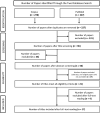A Systematic Literature Review of Safety Culture in Hemodialysis Settings
- PMID: 37069892
- PMCID: PMC10105578
- DOI: 10.2147/JMDH.S407409
A Systematic Literature Review of Safety Culture in Hemodialysis Settings
Abstract
Background: Safety culture is an important aspect of quality in healthcare settings. There are many risks that patients can encounter in hemodialysis settings one of which is the infection risks due to the regular need to access bloodstreams using catheters and needles. Implementation of prevention guidelines, protocols and strategies that reinforce safety culture excellence are essential to mitigate risks. The objective of this study was to identify and characterize the main strategies that enhance and improve patient safety culture in hemodialysis settings.
Methods: Medline (via PubMed) and Scopus were searched from 2010 to 2020 in English. Terms defining safety culture, patient safety were combined with the term hemodialysis during the search. The studies were chosen based on inclusion criteria.
Results: A total of 17 articles reporting on six countries were identified that met inclusion criteria following the PRISMA statement. From the 17 papers, practices that were successfully applied to improve safety culture in hemodialysis settings included (i) training of nurses on the technologies used in hemodialysis treatment, (ii) proactive risk identification tools to prevent infections (iii) root cause analysis in evaluating the errors, (iv) hemodialysis checklist to be used by the dialysis nurses to reduce the adverse events, and (v) effective communication and mutual trust between the employee and leadership to support no-blame environment, and improve the safety culture.
Conclusion: This systematic review provided significant insights on the strategies that healthcare safety managers and policy makers can implement to enhance safety culture in hemodialysis settings.
Keywords: hemodialysis; kidney care; medical error; patient safety; quality improvement; safety culture.
© 2023 Albreiki et al.
Conflict of interest statement
Professor Krista Lentine reports personal fees from CareDx, personal fees from Sanofi, outside the submitted work. The authors report no other conflicts of interest in this work.
Figures
Similar articles
-
Beyond the black stump: rapid reviews of health research issues affecting regional, rural and remote Australia.Med J Aust. 2020 Dec;213 Suppl 11:S3-S32.e1. doi: 10.5694/mja2.50881. Med J Aust. 2020. PMID: 33314144
-
The future of Cochrane Neonatal.Early Hum Dev. 2020 Nov;150:105191. doi: 10.1016/j.earlhumdev.2020.105191. Epub 2020 Sep 12. Early Hum Dev. 2020. PMID: 33036834
-
Promoting and supporting self-management for adults living in the community with physical chronic illness: A systematic review of the effectiveness and meaningfulness of the patient-practitioner encounter.JBI Libr Syst Rev. 2009;7(13):492-582. doi: 10.11124/01938924-200907130-00001. JBI Libr Syst Rev. 2009. PMID: 27819974
-
The Barriers and Enhancers to Trust in a Just Culture in Hospital Settings: A Systematic Review.J Patient Saf. 2022 Oct 1;18(7):e1067-e1075. doi: 10.1097/PTS.0000000000001012. Epub 2022 May 19. J Patient Saf. 2022. PMID: 35588066
-
Making health care safer: a critical analysis of patient safety practices.Evid Rep Technol Assess (Summ). 2001;(43):i-x, 1-668. Evid Rep Technol Assess (Summ). 2001. PMID: 11510252 Free PMC article. Review.
References
-
- Waterson P, ed. Patient Safety Culture: Theory, Methods and Application. 1st ed. CRC Press; 2018. doi:10.1201/9781315599717 - DOI
-
- Simsekler MCE, Qazi A, Alalami MA, Ellahham S, Ozonoff A. Evaluation of patient safety culture using a random forest algorithm. Reliability Eng Sys Safety. 2020;204:107186. doi:10.1016/j.ress.2020.107186 - DOI
-
- Sinangil A, Koc Y, Unsal A, et al. Effects of infectious complications on patients’ survival in peritoneal dialysis. Eur Rev Med Pharmacol Sci. 2013;17(8):1064. - PubMed
Publication types
LinkOut - more resources
Full Text Sources
Research Materials
Miscellaneous



